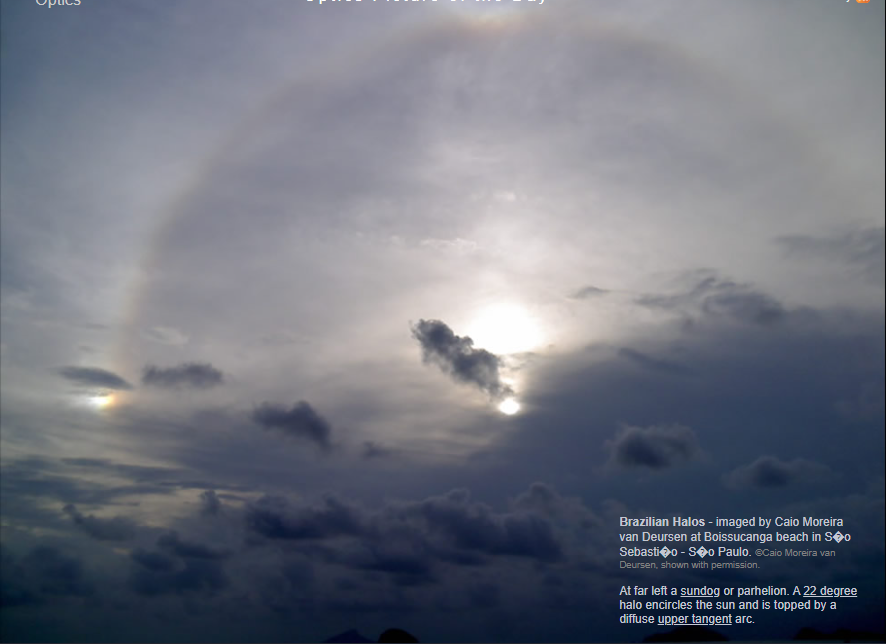Brazil Halos
Brazil Halos: A Spectacular Atmospheric Phenomenon
Brazil is known for its vibrant culture, beautiful landscapes, and diverse wildlife. But did you know that Brazil is also home to some breathtaking atmospheric optics phenomena? One such phenomenon is the occurrence of halos in the Brazilian skies. These mesmerizing displays of light are a result of the interaction between sunlight and ice crystals suspended in the atmosphere. In this article, we will explore the fascinating world of Brazil halos and uncover the science behind these stunning optical phenomena.
Understanding Halos
Halos are optical phenomena that occur when sunlight interacts with ice crystals in the atmosphere. These crystals act as tiny prisms, bending and refracting the sunlight, resulting in the formation of colorful rings or arcs around the sun or moon. While halos can be observed in various parts of the world, the unique atmospheric conditions in Brazil create a particularly captivating display.
The Sundog or Parhelion
One of the prominent features of Brazil halos is the appearance of sundogs or parhelia. Sundogs are bright spots that appear on either side of the sun, resembling two additional suns. These spots are caused by the refraction of sunlight through hexagonal ice crystals. The presence of sundogs adds an extra layer of beauty to the already mesmerizing halo display.
The 22 Degree Halo
Another striking feature of Brazil halos is the presence of a 22 degree halo. This halo encircles the sun and is formed by the refraction of sunlight through hexagonal ice crystals. The 22 degree halo gets its name from its radius, which measures approximately 22 degrees from the sun. This halo appears as a circular ring of light around the sun and is often accompanied by other optical phenomena.
The Upper Tangent Arc
Topping the 22 degree halo in Brazil halos is a diffuse upper tangent arc. This arc appears as a faint, whitish band of light extending from the top of the halo. The upper tangent arc is caused by the refraction and reflection of sunlight within the ice crystals. Its diffuse nature adds an ethereal touch to the overall halo display.
Atmospheric Conditions in Brazil
The unique atmospheric conditions in Brazil contribute to the formation of these captivating halos. Brazil's diverse climate, which includes tropical rainforests, savannas, and coastal regions, provides a rich environment for the formation of ice crystals. Additionally, the prevalence of high humidity and frequent convective activity in certain regions of Brazil creates the ideal conditions for the development of these optical phenomena.
Other Atmospheric Optics Phenomena in Brazil
While halos are a prominent atmospheric optics phenomenon observed in Brazil, they are not the only spectacle to behold. Brazil is also known for other mesmerizing phenomena such as rainbows, crepuscular rays, and iridescent clouds. These phenomena further showcase the beauty and diversity of the Brazilian skies.
Appreciating the Beauty of Brazil Halos
The beauty of Brazil halos lies not only in their visual appeal but also in the scientific understanding behind their formation. Studying these optical phenomena helps scientists gain insights into the physics of light and the behavior of ice crystals in the atmosphere. Moreover, these displays serve as a reminder of the intricate interplay between nature and light, showcasing the wonders that can be found in even the simplest interactions.
Capturing Brazil Halos
Photographers and enthusiasts from around the world flock to Brazil to capture the awe-inspiring beauty of these halos. The unique combination of atmospheric conditions and stunning landscapes makes Brazil an ideal destination for witnessing and photographing these optical phenomena. From pristine beaches to dense rainforests, Brazil offers a diverse range of backdrops to complement the halo displays.
Conclusion
Brazil halos are a testament to the captivating beauty of nature's optical phenomena. From the sundogs and the 22 degree halo to the upper tangent arc, these displays of light in the Brazilian skies leave observers in awe. By understanding the science behind these halos and appreciating their visual splendor, we gain a deeper appreciation for the wonders of our natural world. So, the next time you find yourself in Brazil, keep an eye on the skies and be prepared to witness the enchanting dance of light that is the Brazil halos.

Brazilian Halos - imaged by Caio Moreira van Deursen at Boissucanga beach in S�o Sebasti�o - S�o Paulo. ©Caio Moreira van Deursen, shown with permission.
At far left a sundog or parhelion. A 22 degree halo encircles the sun and is topped by a diffuse upper tangent arc.
Note: this article has been automatically converted from the old site and may not appear as intended. You can find the original article here.
Reference Atmospheric Optics
If you use any of the definitions, information, or data presented on Atmospheric Optics, please copy the link or reference below to properly credit us as the reference source. Thank you!
-
<a href="https://atoptics.co.uk/blog/brazil-halos-2/">Brazil Halos</a>
-
"Brazil Halos". Atmospheric Optics. Accessed on April 19, 2024. https://atoptics.co.uk/blog/brazil-halos-2/.
-
"Brazil Halos". Atmospheric Optics, https://atoptics.co.uk/blog/brazil-halos-2/. Accessed 19 April, 2024
-
Brazil Halos. Atmospheric Optics. Retrieved from https://atoptics.co.uk/blog/brazil-halos-2/.